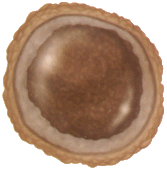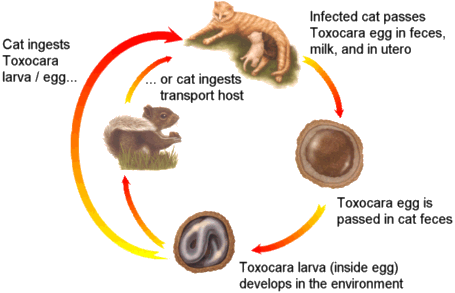There are two species of roundworms affecting cats and kittens: Toxocara cati and Toxascaris leonina. Both are treated with the same medication protocol so when eggs are seen on a fecal flotation exam it is not necessary to determine which species is present. T. leonina can infect both dogs and cats so identifying this roundworm might be helpful in indicating which pets in the household are at risk for further contagion.
How Infection Occurs
In cats, there are three ways by which infection with Toxocara cati occurs:
- Consuming infective worm eggs from soil in the environment, generally through normal grooming.
- Nursing from a mother cat that was herself infected in late ate pregnancy; most kittens are infected this way.
- Consuming a prey animal – usually a rodent – that is carrying developing worms.
Note: dogs cannot be infected with Toxocara cati. They have their own roundworm: Toxocara canis.
Life as a Roundworm
Toxocara cati has one of the most amazing life cycles in the animal kingdom. It is crucial to understand this life cycle if effective treatment is to be pursued.
|
Step One: Toxocara eggs are passed in the host’s feces. If a fecal sample is tested, the eggs can be detected. The embryonic worm develops in the outdoor environment for one month before it becomes able to infect a new host. This will take about a month for the egg to become infective. However, if the conditions are not favourable, eggs can remain infective for months to years.
Step Two: The egg the second stage larva is picked up orally by a cat or by some other animal. The egg hatches in the new host’s intestinal tract and the young worm burrows its way out of the intestinal tract to enclose in the host’s other body tissues. If the new host is a cat, the life cycle proceeds. If the new host is a member of another species, such as a rodent, the larvae wait until the new host is eaten by a cat. These prey animals that carry worm larvae are called paratenic hosts. The cat is called the definitive host.
Step Three: These second stage larvae can remain encysted happily for years. If the host is a cat, though, most larvae waste no time encysting and continue their migration straight to the lungs. The majority of the incoming larvae have reached the cat’s lungs by the third day post-infection. Those larvae that do stay behind encysted do so in the cat’s liver. Once they get to the lung, they develop into third stage larvae and burrow into the small airways, ultimately travelling upward towards the host’s throat. A heavy infection can produce a serious pneumonia. When they get to the upper airways, they generate coughing. The worms are coughed up into the host’s throat where they are swallowed, thus entering the intestinal tract for the second time in their development.
If the host is a nursing mother, second stage larvae can migrate to the mammary gland instead of the lung. Kittens can thus be infected by drinking their mother’s milk. Larvae that had encysted in the liver and gone dormant will re-awaken during the host’s pregnancy, continuing their migration just in time to infect the nursing kittens. In this way, a well dewormed mother cat can still find herself infecting her kittens.
Step Four: Once back in the intestine, the larvae complete their maturation and begin to mate. The first eggs are laid about one week after the fourth stage larvae have arrived in the intestine and about 4 to 5 weeks after infection has first occurred. From here the cycle repeats.
Why is Infection Bad?
Roundworm infection can have numerous negative effects. It is a common cause of diarrhea in young animals and can cause vomiting as well. Sometimes the worms are vomited up, which can be alarming because they can be quite large with females reaching lengths of up to seven inches. The worms consume the host’s food and can lead to unthriftiness and a classical pot-bellied appearance. Heavy infections can lead to pneumonia as the worms migrate and, if there are enough worms, the intestine can become obstructed.
How do we know if our Cat is Infected?
You may not know and this is one of the arguments in favour of regular deworming. Regular deworming is especially recommended for cats that hunt and might consume the flesh of hosts carrying worm larvae. Kittens are frequently simply assumed to be infected and automatically dewormed.
 Toxocara egg
Toxocara egg
Of course, there are ways to find out if your pet is infected. If a cat or kitten vomits up a worm, there is a good chance this is a roundworm, especially in a kitten. Roundworms are long, white and described as looking like spaghetti. Tapeworms can also be vomited up but these are flat and obviously segmented. If you are not sure what type of worm you are seeing, take it to your vet for them to identify it for you.There are numerous deworming products available and all are very effective. Some are over the counter and some are prescription. Many flea control prevention products provide a monthly deworming, which is especially helpful in minimizing environmental contamination.There are two important concepts to keep in mind about deworming. Medications essentially anaesthetise the worm so that it lets go of its grip on the host’s intestine and it passes out with the stool. Once it has been passed, it cannot survive in the environment and dies.This means that you will likely see the worms when they pass so be prepared as they can be quite long and may still be alive and moving when you see them.The other concept stems from the fact that larvae in migration cannot be killed by most deworming products. After the worms are cleared from the intestine, they will be replaced by new worms completing their migration. This means that a second, and sometimes even a third deworming is needed to keep the intestine clear. The follow-up deworming is generally given several weeks following the first deworming to allow for migrating worms to arrive in the intestine where they are vulnerable.Do not forget your follow-up deworming.


No comments yet.